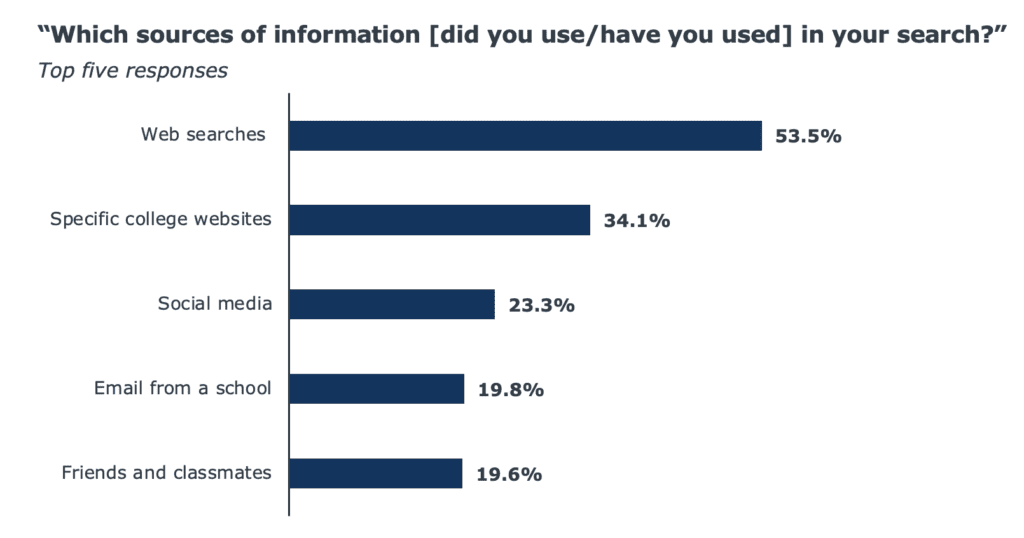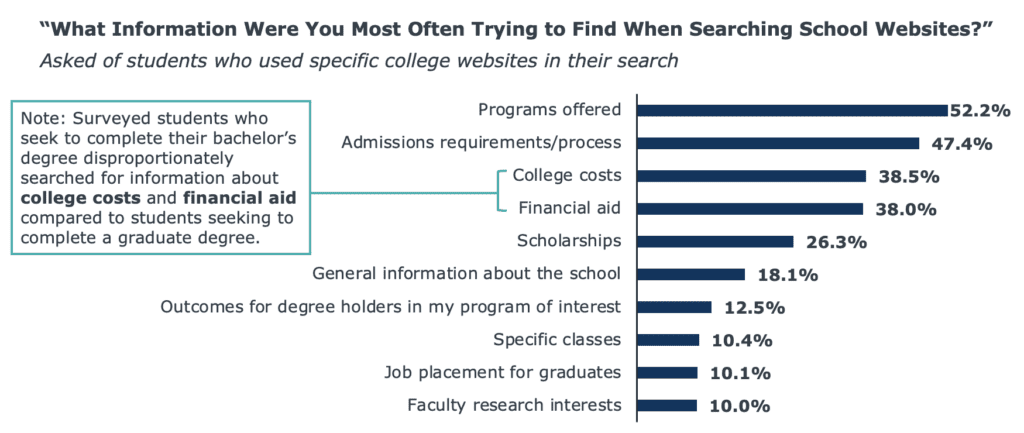The top 5 ways prospective graduate and adult learners are finding your programs
It may be hard to believe, but many of your current adult learners—and the students making their way through the enrollment funnel for your graduate and adult programs right now—belong to Gen Z. By 2024, 31% of the adult learner market will be Gen Z. And the portion of adult learners from Gen Z is expected to grow to 60% by 2031.
With these demographic shifts come changes in the way adult learners research and compare academic programs. Our Adult Learner Recruitment team recently surveyed more than 3,800 graduate and adult learners to learn more about the ways students search for programs. Here’s what we learned about how long students are spending researching programs—and the channels they are using to explore options.
How long are students spending researching their options?
Our survey revealed key differences in the way student populations research their options. More than half of prospective adult degree completers said they spent no more than six months researching programs. By contrast, students interested in master’s or doctorate degrees typically explored options over a longer period. Forty-three percent of prospective graduate students spent at least one year researching programs. International students and students interested in legal education programs (JD, LLM) spend the most time researching programs, perhaps because of the additional application requirements these students face.
Graduate enrollment leaders keep up with changing recruitment expectations
What channels are students using to explore programs?
Surveyed students most often relied on web searches, specific college and university websites, social media, email, and conversations with friends and family to learn more about furthering their education.

Let’s look at the way students are using each of these sources—and how university leaders can ensure they’re reaching students on the platforms they use most.
Search engines
The rise of stealth shopping means that it’s more important than ever that your university webpage appears on search engines. More than half of surveyed students say they used web searches to research institution or program options. For this reason, ensure paid search and SEO efforts are part of your marketing strategy. Our experts recommend near-constant monitoring of paid search campaigns to make sure you’re making the most of your paid search budget. Or consider how an external vendor can support your paid search efforts. Due to the time and expertise required to manage paid search campaigns, many schools enlist the help of external specialists to manage the parameters below.
Primary campaign parameters
-
Keyword
- Keyword terms
- Keyword match types
-
Budget
- Daily budget
- Max cost-per-click
-
Creative components
- Ad text and imagery
- Ad format and placement
- Landing page text and imagery
-
Targeting specifications
- Geographic
- Demographic
- Remarketing and customer match lists
University webpages
More than one-third of surveyed students said they consult university webpages when exploring options. Most students who looked at university websites as part of their search are under age 26, a testament to the importance of your program webpage in engaging Gen Z.
What one prospective learner said about how your website can make an impact
So what information are students looking for when they’re on your site? More than half of surveyed students said they are looking for information about programs offered. Ensure students can easily navigate to a full list of programs available at your institution. Students also frequently seek information about college costs (39%) and financial aid (38%). Ensure information about tuition, fees, financial aid, and scholarships is readily available across your website.

Your website provides an important first impression. If students can’t find the information they need easily and quickly, they may navigate away from your site and disregard your institution. Eighty-nine percent of respondents said a well-designed website improves their opinion of a school, while 84% said a poorly designed website will negatively impact their opinion of that institution.
-
84%
of surveyed students said a poorly designed website will negatively impact their opinion of an institution.
Social media
Twenty-three percent of the students we surveyed said they used social media to research institutions and programs—and all students in our survey said they are open to receiving ads from colleges and universities on at least some social media channels. Respondents aged 25 and younger are most open to receiving ads on Instagram, while students 26-35 are most open to ads on LinkedIn. Students aged 35 and older are most open to receiving ads on Facebook.

While it’s important to keep an eye on new and emerging channels, don’t overlook tried-and-true channels like email. Nearly 20% of students said they consulted emails from colleges and universities during their search, up from 13% in our 2021 survey.
Struggling to recruit adult learners? Start by auditing your emails.
Our Adult Learner Recruitment experts expect email to play an increasingly important role in communication in the years to come. Surveyed students aged 25 and under (Gen Z) more often relied on email from colleges and universities than their older peers. And EAB’s survey of high school students (conducted earlier this year) revealed that more than 75% of current high school students want to hear from colleges and universities via email.
Using email drip campaigns to recruit students? Here’s what you’re missing.
Word of mouth
Finally, about 20% of students in our survey consulted friends and family in their search for programs. Consider ways your institution can make it easy for current and former students to share information about your institution and programs. For example, ask students to provide testimonials when they’re especially likely to do so (perhaps immediately after completing a course or submitting a grade request). Or, consider training and offering a small incentive for motivated alumni to share information about your institution with prospective students in their networks.
Here’s how to show students your master’s program is “worth it”
The significant time graduate and adult learners spend researching programs—and the variety of channels they use to learn more about going back to school variety of ways students research programs—speaks to the needs of a multi-channel marketing strategy. Today’s adult learners expect nothing less.

More Blogs

4 questions domestic students will ask before applying to your graduate program

When Grad PLUS disappears: What 8,000+ grad students said about paying for school
